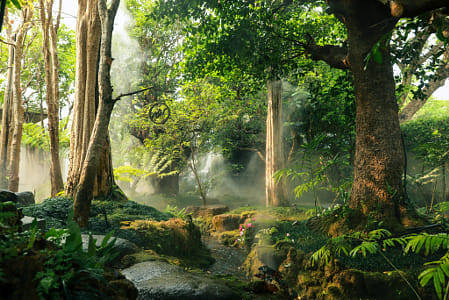
lmw73
76 posts
Latest Posts by lmw73


Lunar halo
@picabuzz

Astronomers used three of NASA's Great Observatories to capture this multiwavelength image showing galaxy cluster IDCS J1426.5+3508. It includes X-rays recorded by the Chandra X-ray Observatory in blue, visible light observed by the Hubble Space Telescope in green, and infrared light from the Spitzer Space Telescope in red. This rare galaxy cluster has important implications for understanding how these megastructures formed and evolved early in the universe.
How Astronomers Time Travel
Let’s add another item to your travel bucket list: the early universe! You don’t need the type of time machine you see in sci-fi movies, and you don’t have to worry about getting trapped in the past. You don’t even need to leave the comfort of your home! All you need is a powerful space-based telescope.
But let’s start small and work our way up to the farthest reaches of space. We’ll explain how it all works along the way.

This animation illustrates how fast light travels between Earth and the Moon. The farther light has to travel, the more noticeable its speed limit becomes.
The speed of light is superfast, but it isn’t infinite. It travels at about 186,000 miles (300 million meters) per second. That means that it takes time for the light from any object to reach our eyes. The farther it is, the more time it takes.
You can see nearby things basically in real time because the light travel time isn’t long enough to make a difference. Even if an object is 100 miles (161 kilometers) away, it takes just 0.0005 seconds for light to travel that far. But on astronomical scales, the effects become noticeable.

This infographic shows how long it takes light to travel to different planets in our solar system.
Within our solar system, light’s speed limit means it can take a while to communicate back and forth between spacecraft and ground stations on Earth. We see the Moon, Sun, and planets as they were slightly in the past, but it's not usually far enough back to be scientifically interesting.
As we peer farther out into our galaxy, we use light-years to talk about distances. Smaller units like miles or kilometers would be too overwhelming and we’d lose a sense of their meaning. One light-year – the distance light travels in a year – is nearly 6 trillion miles (9.5 trillion kilometers). And that’s just a tiny baby step into the cosmos.
The Sun’s closest neighboring star, Proxima Centauri, is 4.2 light-years away. That means we see it as it was about four years ago. Betelgeuse, a more distant (and more volatile) stellar neighbor, is around 700 light-years away. Because of light’s lag time, astronomers don’t know for sure whether this supergiant star is still there! It may have already blasted itself apart in a supernova explosion – but it probably has another 10,000 years or more to go.

What looks much like craggy mountains on a moonlit evening is actually the edge of a nearby, young, star-forming region NGC 3324 in the Carina Nebula. Captured in infrared light by the Near-Infrared Camera (NIRCam) on NASA’s James Webb Space Telescope, this image reveals previously obscured areas of star birth.
The Carina Nebula clocks in at 7,500 light-years away, which means the light we receive from it today began its journey about 3,000 years before the pyramids of Giza in Egypt were built! Many new stars there have undoubtedly been born by now, but their light may not reach Earth for thousands of years.

An artist’s concept of our Milky Way galaxy, with rough locations for the Sun and Carina nebula marked.
If we zoom way out, you can see that 7,500 light-years away is still pretty much within our neighborhood. Let’s look further back in time…

This stunning image by the NASA/ESA Hubble Space Telescope features the spiral galaxy NGC 5643. Looking this good isn’t easy; 30 different exposures, for a total of nine hours of observation time, together with Hubble’s high resolution and clarity, were needed to produce an image of such exquisite detail and beauty.
Peering outside our Milky Way galaxy transports us much further into the past. The Andromeda galaxy, our nearest large galactic neighbor, is about 2.5 million light-years away. And that’s still pretty close, as far as the universe goes. The image above shows the spiral galaxy NGC 5643, which is about 60 million light-years away! That means we see it as it was about 60 million years ago.
As telescopes look deeper into the universe, they capture snapshots in time from different cosmic eras. Astronomers can stitch those snapshots together to unravel things like galaxy evolution. The closest ones are more mature; we see them nearly as they truly are in the present day because their light doesn’t have to travel as far to reach us. We can’t rewind those galaxies (or our own), but we can get clues about how they likely developed. Looking at galaxies that are farther and farther away means seeing these star cities in ever earlier stages of development.
The farthest galaxies we can see are both old and young. They’re billions of years old now, and the light we receive from them is ancient since it took so long to traverse the cosmos. But since their light was emitted when the galaxies were young, it gives us a view of their infancy.

This animation is an artist’s concept of the big bang, with representations of the early universe and its expansion.
Comparing how fast objects at different distances are moving away opened up the biggest mystery in modern astronomy: cosmic acceleration. The universe was already expanding as a result of the big bang, but astronomers expected it to slow down over time. Instead, it’s speeding up!
The universe’s expansion makes it tricky to talk about the distances of the farthest objects. We often use lookback time, which is the amount of time it took for an object’s light to reach us. That’s simpler than using a literal distance, because an object that was 10 billion light-years away when it emitted the light we received from it would actually be more than 16 billion light-years away right now, due to the expansion of space. We can even see objects that are presently over 30 billion light-years from Earth, even though the universe is only about 14 billion years old.

This James Webb Space Telescope image shines with the light from galaxies that are more than 13.4 billion years old, dating back to less than 400 million years after the big bang.
Our James Webb Space Telescope has helped us time travel back more than 13.4 billion years, to when the universe was less than 400 million years old. When our Nancy Grace Roman Space Telescope launches in a few years, astronomers will pair its vast view of space with Webb’s zooming capabilities to study the early universe in better ways than ever before. And don’t worry – these telescopes will make plenty of pit stops along the way at other exciting cosmic destinations across space and time.
Learn more about the exciting science Roman will investigate on X and Facebook.
Make sure to follow us on Tumblr for your regular dose of space!

ryandyar

cinemagraph artist: kitchenghosts
goodnight 🌄
beautiful 🌄
Looking back down the Marsyangdi River Valley, Himalayas, Nepal


Arun Prem (Indian)
Green Lake, 2020
Oil on canvas
Bachalpsee, Kanton Bern, Switzerland




Courageous Young Advocates Honored at 2nd Annual Animal Hero Kids Awards Show
🐾🌄🙏🐾




This Artist Creates the Most Realistic Animal Portraits We’ve Ever Seen

“There is nothing greater you can give to yourself along with future generations than to completely care for, nourish, and heal our bodies and planet by living a natural, organic, cruelty free lifestyle.”
“Be the change you want to see in the world." ~ Mahatma Ghandi

Animal agriculture is one of the most resource-intensive industries on the planet and is currently responsible for 51 percent of global greenhouse gas emissions. At our current world population of seven billion, we are already expending 70 percent of the world’s freshwater and 45 percent of arable land resources for the livestock system.
#EatForThePlanet
CIAT/Flickr
#eatfortheplanet #vegan #veganshare #vegansofig #plantbased #plantpower #healthy #eatclean #yum #foodporn #food #veganfoodporn #veganfood #vegancooking #veggieinspired #plantbasedcooking #plantbased #veg #eatgreen #eatclean #veganfoodshare #meatfree #meatless #dairyfree #plantpower #whatveganseat
naaw 🐾😽
mesmerizing 🌄
that's cute 🐾🌄


(by Jonny Gios)

Astronomers used three of NASA's Great Observatories to capture this multiwavelength image showing galaxy cluster IDCS J1426.5+3508. It includes X-rays recorded by the Chandra X-ray Observatory in blue, visible light observed by the Hubble Space Telescope in green, and infrared light from the Spitzer Space Telescope in red. This rare galaxy cluster has important implications for understanding how these megastructures formed and evolved early in the universe.
How Astronomers Time Travel
Let’s add another item to your travel bucket list: the early universe! You don’t need the type of time machine you see in sci-fi movies, and you don’t have to worry about getting trapped in the past. You don’t even need to leave the comfort of your home! All you need is a powerful space-based telescope.
But let’s start small and work our way up to the farthest reaches of space. We’ll explain how it all works along the way.

This animation illustrates how fast light travels between Earth and the Moon. The farther light has to travel, the more noticeable its speed limit becomes.
The speed of light is superfast, but it isn’t infinite. It travels at about 186,000 miles (300 million meters) per second. That means that it takes time for the light from any object to reach our eyes. The farther it is, the more time it takes.
You can see nearby things basically in real time because the light travel time isn’t long enough to make a difference. Even if an object is 100 miles (161 kilometers) away, it takes just 0.0005 seconds for light to travel that far. But on astronomical scales, the effects become noticeable.

This infographic shows how long it takes light to travel to different planets in our solar system.
Within our solar system, light’s speed limit means it can take a while to communicate back and forth between spacecraft and ground stations on Earth. We see the Moon, Sun, and planets as they were slightly in the past, but it's not usually far enough back to be scientifically interesting.
As we peer farther out into our galaxy, we use light-years to talk about distances. Smaller units like miles or kilometers would be too overwhelming and we’d lose a sense of their meaning. One light-year – the distance light travels in a year – is nearly 6 trillion miles (9.5 trillion kilometers). And that’s just a tiny baby step into the cosmos.
The Sun’s closest neighboring star, Proxima Centauri, is 4.2 light-years away. That means we see it as it was about four years ago. Betelgeuse, a more distant (and more volatile) stellar neighbor, is around 700 light-years away. Because of light’s lag time, astronomers don’t know for sure whether this supergiant star is still there! It may have already blasted itself apart in a supernova explosion – but it probably has another 10,000 years or more to go.

What looks much like craggy mountains on a moonlit evening is actually the edge of a nearby, young, star-forming region NGC 3324 in the Carina Nebula. Captured in infrared light by the Near-Infrared Camera (NIRCam) on NASA’s James Webb Space Telescope, this image reveals previously obscured areas of star birth.
The Carina Nebula clocks in at 7,500 light-years away, which means the light we receive from it today began its journey about 3,000 years before the pyramids of Giza in Egypt were built! Many new stars there have undoubtedly been born by now, but their light may not reach Earth for thousands of years.

An artist’s concept of our Milky Way galaxy, with rough locations for the Sun and Carina nebula marked.
If we zoom way out, you can see that 7,500 light-years away is still pretty much within our neighborhood. Let’s look further back in time…

This stunning image by the NASA/ESA Hubble Space Telescope features the spiral galaxy NGC 5643. Looking this good isn’t easy; 30 different exposures, for a total of nine hours of observation time, together with Hubble’s high resolution and clarity, were needed to produce an image of such exquisite detail and beauty.
Peering outside our Milky Way galaxy transports us much further into the past. The Andromeda galaxy, our nearest large galactic neighbor, is about 2.5 million light-years away. And that’s still pretty close, as far as the universe goes. The image above shows the spiral galaxy NGC 5643, which is about 60 million light-years away! That means we see it as it was about 60 million years ago.
As telescopes look deeper into the universe, they capture snapshots in time from different cosmic eras. Astronomers can stitch those snapshots together to unravel things like galaxy evolution. The closest ones are more mature; we see them nearly as they truly are in the present day because their light doesn’t have to travel as far to reach us. We can’t rewind those galaxies (or our own), but we can get clues about how they likely developed. Looking at galaxies that are farther and farther away means seeing these star cities in ever earlier stages of development.
The farthest galaxies we can see are both old and young. They’re billions of years old now, and the light we receive from them is ancient since it took so long to traverse the cosmos. But since their light was emitted when the galaxies were young, it gives us a view of their infancy.

This animation is an artist’s concept of the big bang, with representations of the early universe and its expansion.
Comparing how fast objects at different distances are moving away opened up the biggest mystery in modern astronomy: cosmic acceleration. The universe was already expanding as a result of the big bang, but astronomers expected it to slow down over time. Instead, it’s speeding up!
The universe’s expansion makes it tricky to talk about the distances of the farthest objects. We often use lookback time, which is the amount of time it took for an object’s light to reach us. That’s simpler than using a literal distance, because an object that was 10 billion light-years away when it emitted the light we received from it would actually be more than 16 billion light-years away right now, due to the expansion of space. We can even see objects that are presently over 30 billion light-years from Earth, even though the universe is only about 14 billion years old.

This James Webb Space Telescope image shines with the light from galaxies that are more than 13.4 billion years old, dating back to less than 400 million years after the big bang.
Our James Webb Space Telescope has helped us time travel back more than 13.4 billion years, to when the universe was less than 400 million years old. When our Nancy Grace Roman Space Telescope launches in a few years, astronomers will pair its vast view of space with Webb’s zooming capabilities to study the early universe in better ways than ever before. And don’t worry – these telescopes will make plenty of pit stops along the way at other exciting cosmic destinations across space and time.
Learn more about the exciting science Roman will investigate on X and Facebook.
Make sure to follow us on Tumblr for your regular dose of space!

What’s It Like to Work in NASA’s Mission Control Center?
In the latest installment of our First Woman graphic novel series, we see Commander Callie Rodriguez embark on the next phase of her trailblazing journey, as she leaves the Moon to take the helm at Mission Control.

Flight directors work in Mission Control to oversee operations of the International Space Station and Artemis missions to the Moon. They have a unique, overarching perspective focused on integration between all the systems that make a mission a success – flight directors have to learn a little about a lot.
Diane Dailey and Chloe Mehring were selected as flight directors in 2021. They’ll be taking your questions about what it’s like to lead teams of flight controllers, engineers, and countless professionals, both agencywide and internationally, in an Answer Time session on Nov. 28, 2023, from noon to 1 p.m. EST (9-10 a.m. PST) here on our Tumblr!
Like Callie, how did their unique backgrounds and previous experience, prepare them for this role? What are they excited about as we return to the Moon?
🚨 Ask your questions now by visiting https://nasa.tumblr.com/ask.
Diane Dailey started her career at NASA in 2006 in the space station Environmental Control and Life Support Systems (ECLSS) group. As an ECLSS flight controller, she logged more than 1,700 hours of console time, supported 10 space shuttle missions, and led the ECLSS team. She transitioned to the Integration and System Engineering (ISE) group, where she was the lead flight controller for the 10th and 21st Commercial Resupply Services missions for SpaceX. In addition, she was the ISE lead for NASA’s SpaceX Demo-1 and Demo-2 crew spacecraft test flights. Dailey was also a capsule communicator (Capcom) controller and instructor.
She was selected as a flight director in 2021 and chose her call sign of “Horizon Flight” during her first shift in November of that year. She has since served as the Lead Flight director for the ISS Expedition 68, led the development of a contingency spacewalk, and led a spacewalk in June to install a new solar array on the space station. She is currently working on development of the upcoming Artemis II mission and the Human Lander Systems which will return humanity to the moon. Dailey was raised in Lubbock, Texas, and graduated from Texas A&M University in College Station with a bachelor’s degree in biomedical engineering. She is married and a mother of two. She enjoys cooking, traveling, and spending time outdoors.
Chloe Mehring started her NASA career in 2008 in the Flight Operations’ propulsion systems group and supported 11 space shuttle missions. She served as propulsion support officer for Exploration Flight Test-1, the first test flight of the Orion spacecraft that will be used for Artemis missions to the Moon. Mehring was also a lead NASA propulsion officer for SpaceX’s Crew Dragon spacecraft and served as backup lead for the Boeing Starliner spacecraft. She was accepted into the 2021 Flight Director class and worked her first shift in February 2022, taking on the call sign “Lion Flight”. Since becoming certified, she has worked over 100 shifts, lead the NG-17 cargo resupply mission team, and executed two United States spacewalks within 10 days of each other. She became certified as a Boeing Starliner Flight Director, sat console for the unmanned test flight in May 2022 (OFT-2) and will be leading the undock team for the first crewed mission on Starliner in the spring of next year. She originally is from Mifflinville, Pennsylvania, and graduated with a bachelor’s degree in aerospace engineering from The Pennsylvania State University in State College. She is a wife, a mom to one boy, and she enjoys fitness, cooking and gardening.

source
gorgeous 🌿🌄🌿



Subtropical Rainforest by JC Terry